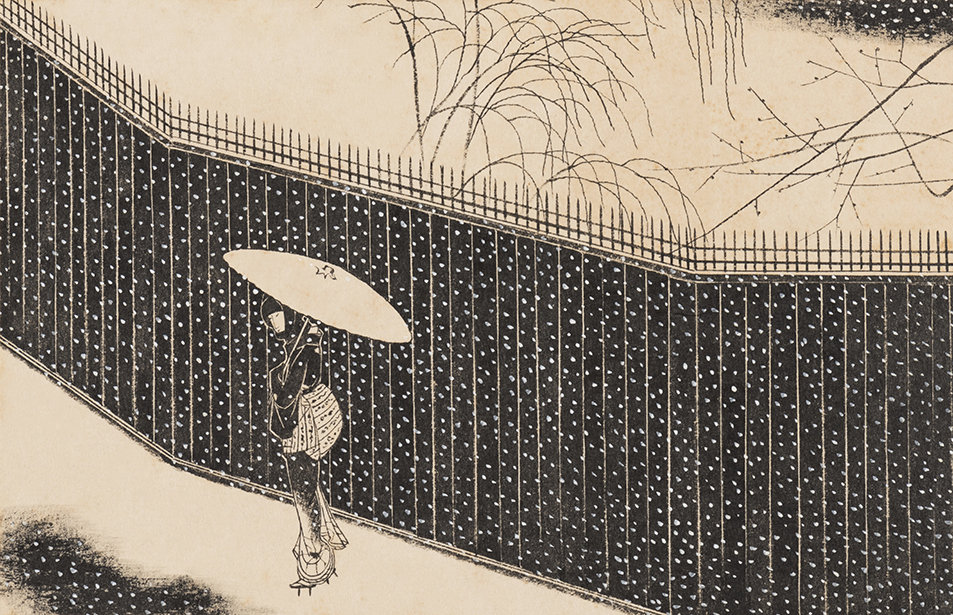Watch, Read, Listen
Recent Additions to the Collection MOMAT Collection Newsletter of the National Museum of Modern Art, Tokyo Komura Settai, Illustration for the Novel Edo Yakusha by Kunieda Kanji, 1932
Back
Illustration for the Novel Edo Yakusha by Kunieda Kanji
1932
Ink on paper (70 illustrations)
Color on paper (2 endpapers)
Album
Illustrations each 15.0 × 23.4 cm
Endpapers each 19.6 × 54.7 cm
Purchased 2023
Komura Settai produced a series of illustrations for Kunieda Kanji’s novel Edo Yakusha [Actor of Edo], which was serialized in 70 installments in the evening editions of the Tokyo Nichi Nichi Shimbun and Osaka Mainichi Shimbun from September 20 to December 28, 1932. The original drawings were rediscovered in 2022, and have since joined the MOMAT collection.
The 70 original illustrations were preserved in an album (also described as an accordion book), with two illustrations per spread, a total of 36 on the obverse and 34 on the reverse. The title slip of the album features the inscription “Edo Yakusha” in Settai’s handwriting. At the back of the album is another inscription by Settai, stamped with his personal seal: “Osaka Mainichi Shimbun / Tokyo Nichi Nichi Shimbun / Serialized novel Edo Yakusha / Written by Kunieda Kanji / Illustrations by Komura Settai.” This indicates that the cherry blossom illustrations on the front and back endpapers, rendered in color, are also Settai’s work. The blossoms likely reference springtime scenes at the Sumida River toward the end of the novel.
The team of novelist Kunieda Kanji and illustrator Komura Settai is best known for Osen, serialized about a year after Edo Yakusha in the evening editions of the Tokyo Asahi Shimbun and Osaka Asahi Shimbun. Osen popularized what came to be called the “Settai style,” defined by clean, unwavering lines, sharp black-and-white contrasts, and bird’s-eye views. However, examination of Edo Yakusha, particularly the original drawings, reveals the hallmark crispness of Settai’s lines, and shows that the “Settai style” which enchanted so many was already fully realized at this stage.
Kunieda himself highly praised Settai’s illustrations for Edo Yakusha:
“Edo Yakusha remains one of my favorite works, and Settai’s illustrations for it were truly excellent. While the illustrations for Osen in the Asahi Shimbun are ranked first by the public, as the author, I personally believe those for Edo Yakusha were superior.”1
Nonetheless, Edo Yakusha is far less well-known than Osen. As Settai scholar Sanada Koji points out, the relative obscurity of Edo Yakusha can be attributed to its illustrations being published in ephemeral newspapers, unlike Osen, which benefited from enduring publications such as Eiri zoushi (Illustrated Book) Osen (Shin-Shosetsusha, 1934) that reproduced the complete series of illustrations.2 The discovery of these original drawings promises to bring renewed attention to Settai’s masterful work on Edo Yakusha.
Notes
1. Kunieda Kanji, “Settai-san,” Sochikutei Essays, Koa Shoin, 1943, p. 151.
2. Sanada Koji, “Commentary: Komura Settai and Kunieda Kanji’s Edo Yakusha,” Edo Yakusha: Tokyo Nichi Nichi Shimbun Evening Edition Serialized Version, Genki Shobo, 2023, p. 231.
(Gendai no me, Newsletter of The National Museum of Modern Art, Tokyo No.639)
Release date :


